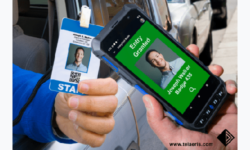Classroom Safety is About More Than Just Securing the Door
When addressing classroom security, also take into consideration protocols, windows, training, visitor management and emergency plans.

Image via Adobe Stock by fpointstudio
With the increase in school shootings and other safety incidents, it’s important to consider all aspects of classroom security to help ensure the safety of students, teachers, and staff. In this article, we’ll discuss various ways to improve classroom security beyond just the door.
Classroom locks come in different types, and it’s essential to choose the right lock for your classroom security needs. Understanding the different recommended applications for each scenario is important for classroom safety.
The Partner Alliance for Safer Schools (PASS) guidelines recommend that classrooms be locked from the inside and should not require a keyholder to step into the hallway to lock the door from the outside. When secured with a key, there is less risk of unauthorized people locking the door, but the keyholder must be present.
Doors that can be secured by a push button or thumb turn are versatile and important for emergency lockdowns. They can be locked from inside by anyone while the inside lever always permits free egress. This solution allows for quicker actions in lockdown emergencies, but students may take advantage of it, creating opportunities for violence and unauthorized activities.
Classroom doors that are secured electronically require a more significant financial investment but provide numerous benefits. They allow for a streamlined lockdown procedure within seconds, are controlled remotely and always permit free egress.
Additionally, they can help manage who may access each door and when, prevent unauthorized access and eliminate the need for keys. Access monitoring and history provide added visibility to events happening at the opening.
Additional Classroom Security Measures to Consider
In addition to door hardware, there are other ways administrators and teachers may consider securing classrooms. For example, protocols matter. Schools may adopt a practice of keeping classroom doors closed and locked at all times. Regular discussion, reviews and practice of these protocols can also make a difference.
One way that is not recommended to reinforce classroom doors is the use of barricade devices. While some marketing efforts point to the affordability and added security of these devices, they can actually introduce new risks and potential liability issues.
Barricade devices violate fire codes and, at minimum, section 309.4 of the Americans with Disabilities Act (ADA): “Operable parts shall be operable with one hand and shall not require tight grasping, pinching, or twisting of the wrist.”
Some devices prohibit egress in emergencies and access to classrooms by emergency responders. Barricade devices may also be used to carry out bullying, violence or vandalism and lock out teachers or staff members.
In perhaps a worst-case scenario, if someone knows how and where to access a barricade device, it can potentially allow a shooter to barricade themselves in a classroom with the intention of injuring others or taking hostages.
Don’t Forget Your Tempered Glass Windows and Sidelites
One part of the door that is often overlooked is tempered glass windows and sidelites. The classroom door window permits natural surveillance. However, a door is only as strong as its weakest point. If tempered glass is not reinforced to prevent forced access, breaking that window and reaching the inside lever can negate the purpose of the door’s lock.
As we’ve seen in some high-profile school tragedies, even though exterior doors may be closed and locked during the school day, perpetrators may be able to enter facilities by shooting and breaking the glass. If the glass is reinforced, the outcome could be different.
While this has encouraged schools to reinforce their exterior doors’ glass, interior doors cannot be overlooked. According to the School Survey on Crime and Safety (SSOCS), in the 2019-2020 school year, about 939,000 violent incidents and 487,000 nonviolent incidents occurred in U.S. public schools, including incidents caused by students on school property.
If a perpetrator is already in the building, it’s important that they are not able to access classrooms to carry out violence by breaking through glass windows or sidelites.
Connected Classrooms Must Also Be Protected
Classroom entrances aren’t the only openings schools should consider. Classrooms connected by passage doors between two rooms should also be secured. Classrooms 111 and 112 in the Uvalde school shooting were connected and unlocked, which allowed the attacker to enter both classrooms without going into the hallway.
Previously, connected classrooms used passage sets without a locking function to allow people to move freely between the rooms. However, since most classrooms don’t require two means of egress, the connecting doors are allowed to be locked at all times and opened only during specific circumstances.
It is usually recommended that connected classroom doors have a locking function and are kept locked unless access to the adjacent classroom is necessary. Be sure to consult your local code requirements.
Look Beyond the Lock
School safety goes beyond just door locks and hardware. It’s important for schools to have adequate training, practices, and emergency preparedness to help ensure a safe environment for all students and staff in every situation, every day.
Classroom Security Training
There are several simple ways to incorporate safety materials and training into classrooms for any grade level, age and ability. First, it is recommended that each classroom have adequate emergency supplies (e.g., trauma kits, wind-up flashlights) and that teachers receive instruction in how to use them. Next, ensure that all communications devices (e.g., telephone, intercom call button) are functional and readily accessible. Telephone speed dial locations should be programmed with emergency extensions (e.g., main desk, nurse’s office) and/or labeled with emergency dialing instructions. Evacuation maps should be up-to-date and accessible.
Provide both teachers and students with sound, age-appropriate instruction in classroom emergency preparedness. Comply with state emergency drill requirements and vary the times of day in which the drills are conducted. Solicit input. Welcome feedback. Make adjustments.
Visitor Management
Having a formal visitor management system in place is important to help protect students and staff from external threats. Classroom locks can only go so far—according to the National Center for Missing and Exploited Children, a significant majority of child abductions are carried out by family members or people they know.
Schools are encouraged to limit visitor access to a single access point, like a secured vestibule, to deter unauthorized student pickups or abductions, confirm visitor identity and help prevent dangerous individuals from entering the facility/campus.
Keeping an updated registry of approved visitors can also help prevent abductions or unauthorized pickups. Schools can issue visitor badges on colored, break-away lanyards once entry is authorized and ensure that visitors are accompanied by staff at all times.
Emergency Operations Plans
Having a current and comprehensive Emergency Operations Plan (EOP) makes a major difference when disaster strikes. Emergencies can happen at any time, so it’s important that staff and students have a thorough understanding of the plan in place.
EOPs dictate what students, teachers and staff should do before, during and after an emergency. Drills and training are key elements to carrying out a successful EOP.
In order to develop an EOP, it’s imperative to know what external and internal threats your school faces. This can include severe weather or natural disasters, bullying and school violence, intruders, fires and more. This guide from SchoolSafety.gov can aid in the steps to take to develop an EOP.
Staff and Student Training
Providing emergency training to staff and students can help increase awareness of threats, improve understanding of their roles within the plan and build a culture of safety. Implementing standardized training at a district level with security professionals and local emergency responders provides an excellent way to involve the community and increase general knowledge of emergency planning.
Involving staff, including teachers, office personnel, custodians and other support staff, can bring empowerment to the school community. Also involving students in such discussions, including student leaders and organizations, brings a new and very important level of awareness both to the students and staff. For example, if students know that violence happens in a certain location on the campus, or they see a potential threat on social media, they can notify staff who may not have otherwise known.
By implementing standardized training that is both clear and actionable, students and staff can feel empowered to prevent and respond to incidents. Individuals who make this kind of personal investment play vital roles in keeping schools safe.
Be Comprehensive with Your Approach
Remember to consider all aspects of classroom security. Undertake a comprehensive approach to protecting students, staff, and visitors. Providing a safe learning environment involves more than just the classroom door.
Paul Timm, PSP, is director of education safety for Allegion.
If you enjoyed this article and want to receive more valuable industry content like this, click here to sign up for our FREE digital newsletters!

Security Is Our Business, Too
For professionals who recommend, buy and install all types of electronic security equipment, a free subscription to Commercial Integrator + Security Sales & Integration is like having a consultant on call. You’ll find an ideal balance of technology and business coverage, with installation tips and techniques for products and updates on how to add to your bottom line.
A FREE subscription to the top resource for security and integration industry will prove to be invaluable.







